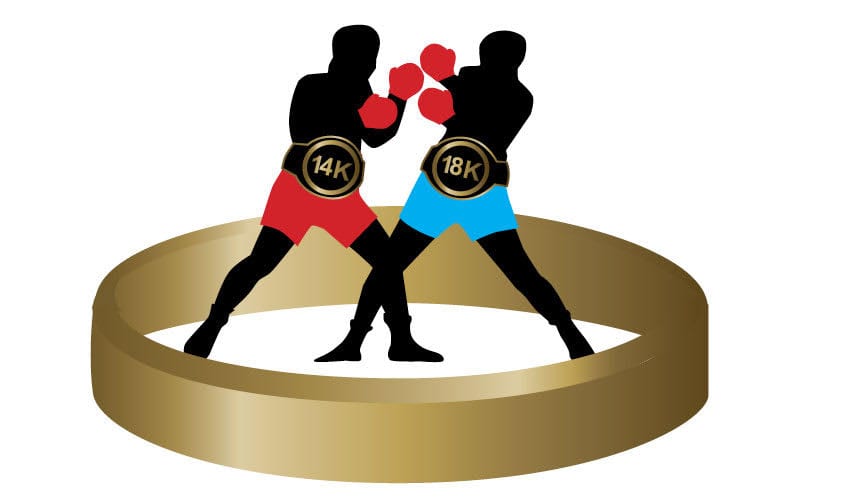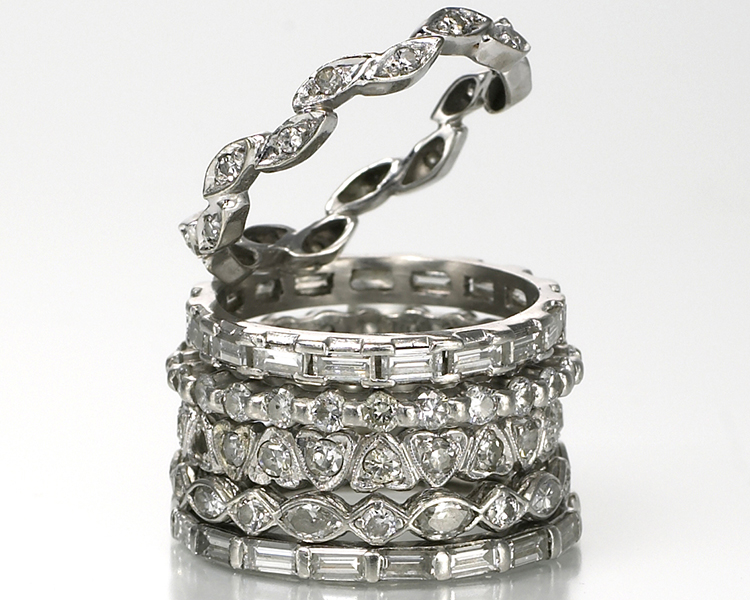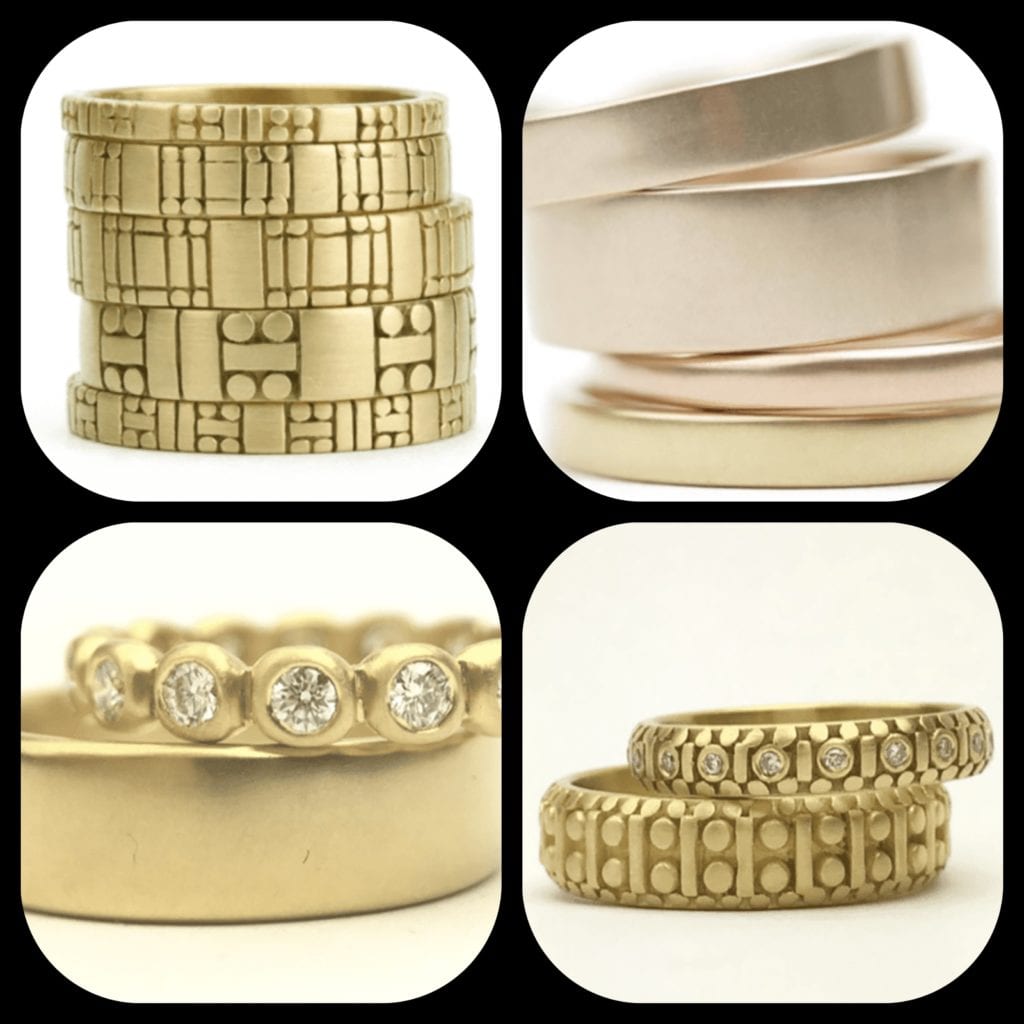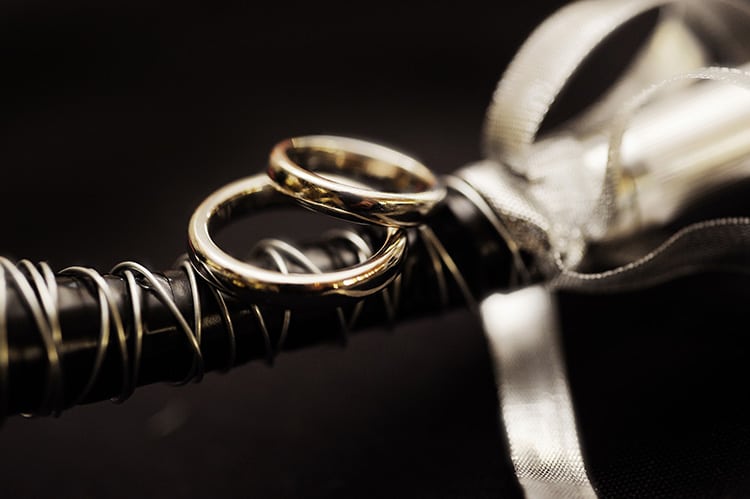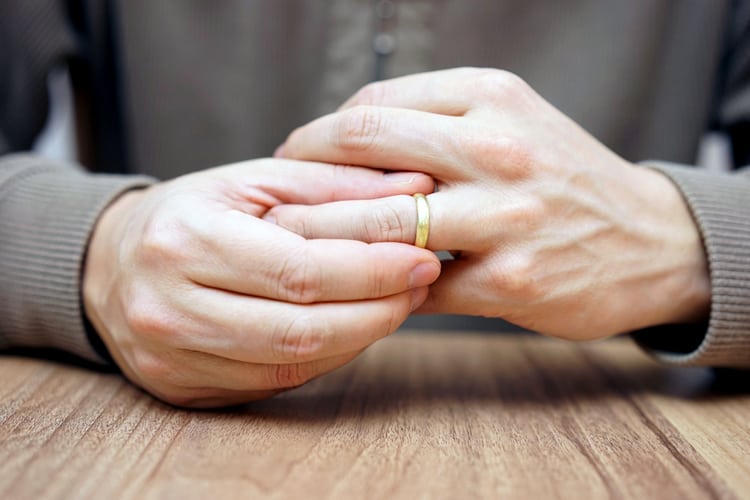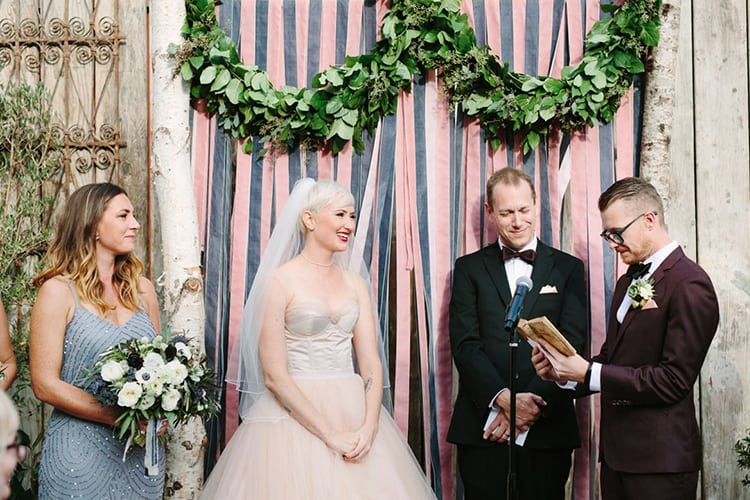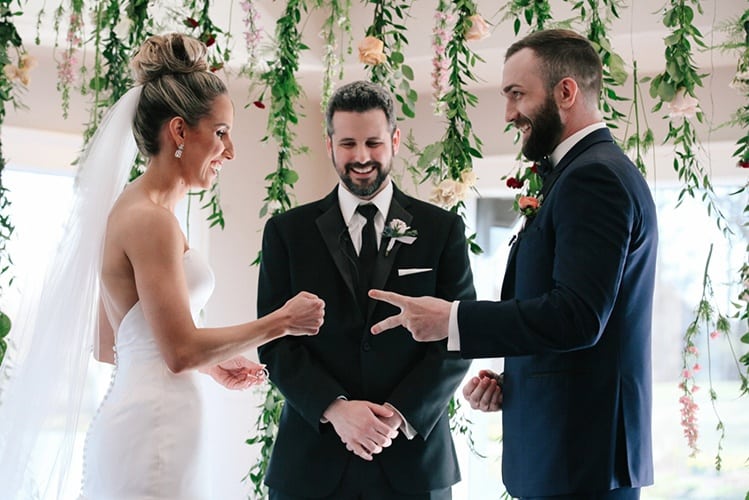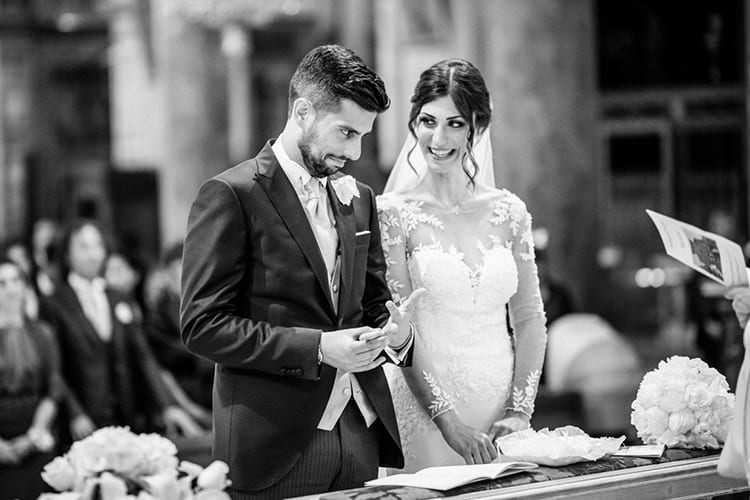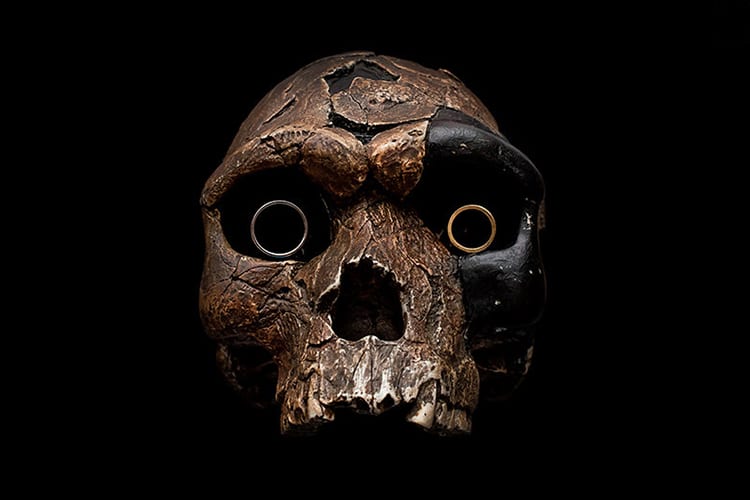
Wedding rings have been around for centuries, a statement of commitment and love since prehistoric times. To this day, they remain heavy with symbolic significance. Knowing the history of wedding rings can help you understand why they’re so important.
First thing’s first: Wedding bands have been around much longer than the modern diamond-clad engagement ring, and while the evolution of the band ebbs and flows, there are a few major turning points that are worth examining. Read on for an explainer on wedding bands throughout the ages.
Prehistoric Times: Crazy Jealous Cavemen
Cavemen exchanged “rings” made of plant materials–twigs, grass, and reeds–to symbolize their commitments to each other. But when the notoriously possessive Neanderthals tied said cords around their beloved’s fingers, ankles, wrists, and even waist, it was used as a means of marking his territory until she accepted him as her mate.
Ancient Egypt (Circa 2800 B.C): The Vena Amoris
Sedges, reeds, and papyrus were twisted and braided into rings worn by women. Because these rings didn’t stand the test of time, they were soon substituted with rings made of leather, bone, and ivory. They were placed on the third finger of the left hand (called the vena amoris, or vein of love) because they believed that a vein ran directly from that finger to the heart. Although there is not a bit of scientific evidence to support it, the sentiment stuck. They saw the ring as a powerful symbol: The circle, with no beginning or end, represented eternity, while its opening signified a gateway to worlds unknown. In short, a sign of immortal love—and how’s that for living happily ever after?
700 B.C.: All Rings Lead To Rome
In Egypt, rings were given as gifts of devotion; in Greece, rings were exchanged between lovers. But it was the Romans who were the first to link the ring to marriage. It was at this time wearing a ring became a public pledge to honor the marriage contract. According to the Roman philosopher Pliny the Elder, brides in his era received two rings on her wedding day. One was a more expensive gold band that was to be worn in public; the other was made of iron to be worn while attending to duties in the home.
1100s: Approved by the Catholic Church
In the 1100s, the Pope declared that marriages celebrated in the Catholic church must include a ring in the ceremony. It wouldn’t be the first time that the Catholic church got involved. During the 9th century, Pope Nicolas I endorsed the idea of engagement rings by making a gold ring a betrothal requirement in order to demonstrate the groom’s wealth and ability to care for a wife. In 1215, Pope Innocent III made a similar declaration though the rings could be made of different metals, including silver and iron. In the early Christian marriages in England, the groom placed a ring on the third finger of the bride’s left hand. One theory thought to be behind the ring being placed on the left hand this: As the priest recited “In the name of the Father, the Son and the Holy Spirit”, he took the ring and touched the thumb, index finger, and middle finger, and while ending on “Amen”, he placed the ring on the ring finger, which sealed the marriage.
1477: The Rise Of The Diamond Betrothal Ring
In one of the first recorded instances of the use of a diamond ring to signify a betrothal, Archduke Maximilian of Austria presented one to Mary of Burgundy in August 1477. Maru’s engagement ring was set with thin, flat pieces of diamonds in the shape of an “M.” This set a glamorous precedent for European nobility, who followed in the Duke’s lead by adding gems to their jewelry, with the diamond being the stone of choice. We also have the Duke to thank for making engagement rings the new standard as young women soon came to expect such things before agreeing to a marriage proposal. And upon being wed, the betrothal ring was joined by an identical version crafted from gold.
15th Century: Gimmel Rings vs. Posy Rings
Gimmel rings were in vogue beginning in the 15th century and through the 17th century. These early stackable rings were constructed of two interlocking bands that fit perfectly together, much like a well-matched couple. Even cuter? The bride and the groom would each wear a band leading up to the big day when they would be joined by a pivot to symbolize their union, and both parts would then be reunited on the bride’s finger. Posy rings—bands engraved with romantic poems and phrases—were also quite popular during this era. In the beginning, posy rings featured bold designs inscribed with words on the outside. But as time went on, the designs became more minimalist, while the sentiments became more detailed. This meant goldsmiths needed to advance their techniques and engrave on the inside to keep these messages private.
1700s: With This Thimble, I Thee Wed
Of course, the Puritans decided that posey rings were frivolous. Young men began giving thimbles instead, which his bride-to-be could use as she sewed linens and clothing for her dowry. While practical at heart, the tokens didn’t make for the most sentimental symbol of marriage. After the wedding, women cut the tops off the thimble and wore the rim as a ring anyways.
Georgian Era (Circa 1714-1830): Bigger Baubles Are Better
During the reign of George I of England, it was not unusual to wear the wedding ring on your thumb after tying the knot, even though at the time of the marriage ceremony it was placed on the fourth finger. This custom may have arisen because of the fashion for exceptionally large wedding rings. Also in the Georgian era, when understated posy rings were still widely used as wedding bands, it became popular for women to wear “keeper” rings on either side of her wedding band to accent and protect it. These rings were commonly made of rose-cut diamonds set in silver and gold, similar to today’s eternity band.
Victorian Era (Circa 1837-1901): The Empire of Bling
During the 1800s, wedding rings in Europe and the United States became more extravagant as discoveries of gold and precious gemstones around the world made these materials more affordable. The notoriously ostentatious Victorians often wore wedding rings made of gold and they featured sapphires, rubies, amethyst, garnet, chalcedony, and topaz, as well as pearls. These blinged-out jewels can also be traced to Queen Victoria, whose tastes in fashion and jewelry inspired the trends of the time. When Queen Victoria wed Prince Albert in 1840, she wore a snake motif ring (seen as a symbol of eternal love) set with her birthstone. Afterward, serpent-inspired wedding bands would become practically de rigueur.
1888: DeBeers Is Forever
In 1888, the DeBeers Company was founded and built the market for wedding bands. They would take the lead in engagement rings, too. You might say the timing was right: In 1867, a seemingly vast supply of diamonds was discovered in the Cape Colony (now South Africa), making the gems more widely available and therefore affordable. After a few short years in business, DeBeers controlled 90 percent of the world’s diamond production. Diamond engagement rings grew in popularity over the 19th century, but they didn’t become standard until DeBeers launched their famous “Diamond is Forever” campaign in 1948, which positioned the precious stone as a sign of love and a lifelong commitment (and encouraged men to spend a months’ salary on the all-important rock.)
1939: When America Goes to War, Soldiers Start Wearing Rings
Although the dual-ring custom has been the tradition in Greek Orthodox weddings since the 1300s, the practice didn’t catch on in America until the beginning of World War II, when young men who were serving had to leave their significant others behind, not knowing when or if they would return. Many couples got hitched in anticipation of the separation and chose dual wedding bands or one for each partner, and for married men fighting overseas, the ring was a comforting reminder of their wives and families back home.
2001: Brad Pitt and Jennifer Aniston Sue Their Own Jeweler
Fast forward to July 2001 when Brad Pitt and Jennifer Aniston sued Dalmani International, which made the wedding and engagement ring Pitt gave Aniston. According to Pitt, the ring was his exclusive design, and when the Italian company sold replicas, it implied they endorsed them. The couple eventually dropped the $50 million federal lawsuit, but there was a catch: Pitt would design an exclusive jewelry collection for Damiani, while Aniston would be featured in the accompanying advertising campaign. In exchange, Dalmani agreed to stop producing the Pitt and Aniston copies.
2008: Beyoncé and Jay-Z Get Married, Get Inked
In April 2008, Beyoncé and Jay-Z tied the knot with an intimate ceremony in New York. Instead of putting a ring on it, they both got matching tattoos of the Roman numeral for 4, or IV, on their ring fingers. The number bears personal significance for the couple. For starters, Bey’s birthday is September 4, while Jay’s birthday is December 4. They also got married on April 4. They took the naming convention one step further when they titled their respective albums 4 and 4:44. Four years later, when the Carters had their first daughter, Blue Ivy, some eagle-eyed fans noticed that her name is a play on IV. After the couple’s relationship hit a very public rough patch, Beyoncé had her tattoo slightly altered, as later confirmed in undated footage of her 2016 visual album, Lemonade. Now, it resembles the number 4 joined with the letter J. Talk about cryptic.
2011: Prince William Rejects Royal Jewels
One month before Prince William married Kate Middleton in May of 2011, Kensington Palace issued a statement explaining that William would not be wearing a wedding band due to personal preference. Prince Charles does wear a wedding ring and has done for both of his marriages, to Princess Diana and later Camilla Parker Bowles, Except the Prince of Wales wears his on his pinky finger next to his signet ring. MANY British men forgo the tradition, often citing a belief that men don’t wear jewelry. This no-ring phenomenon is also indicative of men of a certain echelon. “There are some things that people like [former British Prime Minister] David Cameron will never do, and I think that is probably one of them,” Peter York, coauthor of The Official Sloane Ranger Handbook, told The Telegraph in 2012. York continued: “It is code, like so many of these things . . . there is a group of upper-class people who think the less of that stuff you wear the better, less bling.”
2013: Dax Shepard Pulls a Jay-Z (Sort Of)
In October 2013, Dax Shepard married actress Kristen Bell during a low-key wedding ceremony in front of family and friends in Los Angeles. Shepard honored his new bride by getting a tattoo of a bell on that finger, rather than sporting the traditional wedding band. “I don’t like wearing jewelry, but I felt obliged to warn all the men that I’m taken,” Shepard later joked in an appearance on The Ellen DeGeneres Show. “I thought a tattoo would be fitting. And her last name, conveniently, is an object I could tattoo.”
Today: Wedding Ring Comme Il Faut Around the World
Throughout history, the ideas of marriage have changed along with the styles of rings that represented it. The same could be said for the finger on which the ring is worn.
Weddings rings have been worn on every finger, including the thumb. In some countries (including the US and most English-speaking countries), it is customary to wear the wedding ring on the left hand; in others (including many Orthodox Christian and Eastern European societies), people tend to wear it on their right. In Greece, Russia, and Colombia, newlyweds move the engagement ring to the right hand after the wedding, according to tradition.
There is also a wide variety in terms of ring design. In France and Russia, for instance, wedding rings often consist of three interwoven bands. While it was once considered radical to the point of bohemianism to own a wedding band that looked too different from the engagement ring, the American custom of coordinating the two rings is far from universal. Although it is common in England, many countries do not consider an engagement and wedding ring pairing to be essential.
But no matter what hand you wear your wedding band on, if it is the same hand, it is common to wear your wedding band closer to your heart, meaning you slide it on before the engagement ring. Some brides even go so far as to have their wedding band soldered to their engagement ring, so it becomes one piece of jewelry and represents the marital bond.
While wedding bands have varied throughout the ages, their sentiment remains as significant as ever (and it never hurts to have a little history lesson before saying “I do.”)








